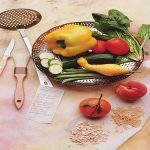
You already know that iceberg lettuce is low on taste and nutrients, but even the best greens can use a punch of flavor to keep your taste buds interested. Here are two ways to enjoy spring greens. Peppery arugula is full of flavor and super low in calories, and it makes a great base for a zesty salad. One of the first greens to appear each spring, arugula pairs well with berries, making this strawberry dressing the perfect complement to its spiciness. Arugula With Strawberry Pepper Dressing 1/2 cup strawberries 2 tablespoons olive oil 2 tablespoons balsamic vinegar 1 tablespoon honey 1/2 teaspoon each salt and freshly ground black pepper 6 cups arugula 4 artichoke hearts, sliced thin 4 small shallots, sliced thin Place the strawberries, olive oil, balsamic vinegar, honey, salt and black pepper in a blender. Process until smooth. Divide the arugula among four plates and top with equal amounts of sliced artichoke hearts and shallots. Drizzle with dressing and serve immediately. Yield: 4 servings For more salad variety, step up to mesclun, a mix of baby greens like romaine, kale, beet greens and spinach — all bursting with vitamins and minerals. This blueberry balsamic dressing imparts a sweet flavor and an antioxidant boost while fresh goat cheese adds protein and richness. Mesclun Salad With Honey Blueberry Dressing 1/4 cup fresh or frozen… read on >


























-300x200.jpg)







-300x169.jpg)
